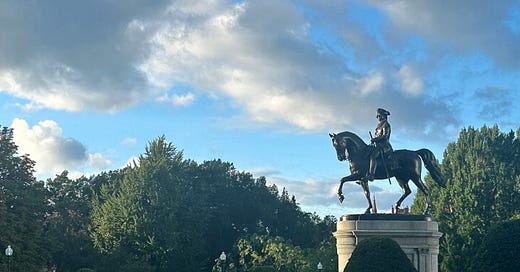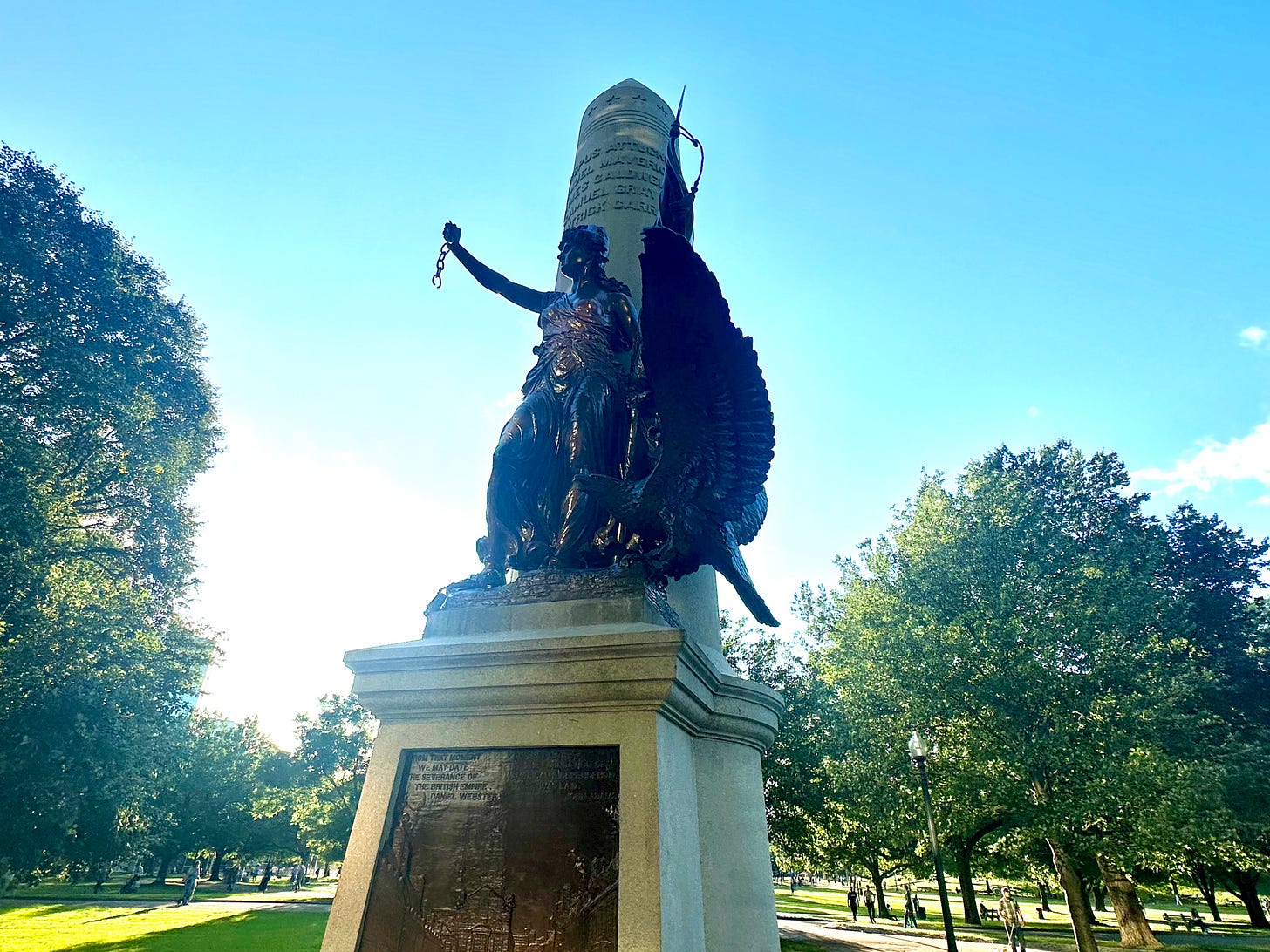Meandering through the Boston Common
How a walk through our nation's oldest public park stirred comparisons with parks back home
Last Tuesday afternoon, I spent an hour walking among statues honoring men who fought alongside my ancestors in a war to form a new country.
I also spent the same hour walking among statues honoring men who fought against my ancestors in a war to form a new country.
Such is the conflicted plight of being a 10th-generation Southerner with ancestors who fought in the Continental and Confederate Armies.
I flew into Boston last Tuesday afternoon for a two-day work conference. After settling into my hotel and finishing off some work tasks, I set out for a 20-minute walk to the Boston Common, the site of the Boston Massacre, a precipitating event of the American Revolution. The sun shone brightly as the temperature hovered around 70 degrees. A steady breeze made it cool enough to feel the beginnings of pre-fall briskness. I needed exercise and fresh air—visiting a historic landmark was an added bonus. But as with many of my walks in new places, my curiosity led me to return with more than Fitbit zone minutes checked off.
When I crossed the street into the Boston Public Garden, which adjoins the Boston Common, I opened Google Maps to see what else was located in the parks. Lots of statues, it turns out.
I began meandering through the parks to see who and what the statues honored. Many focus on the American Revolution. Beyond the Boston Massacre Memorial, which remembers the five Americans killed by British soldiers in 1770, there are statues or plaques with George Washington on his horse, Marquis de Lafayette, Navy Commodore John Barry, and others.
The Civil War also receives its due. The Soldier and Sailors Monument remembers the men of Boston who died “in the war which kept the Union whole, destroyed slavery, and maintained the Constitution.” In the far corner across from the Massachusetts State House, the Robert Gould Shaw and the 54th Regiment Memorial commemorates one of the first black Union military units, many of whom died at Fort Wagner in South Carolina (as depicted in the movie Glory).

I noticed an array of other statues honoring abolitionists, authors, preachers, and other notable Boston figures as well—Wendell Phillips, Edward Everett Hale, Edgar Allen Poe, to name a few. Along with these, there are monuments to Boston’s 300th anniversary, the founder of the first credit union, and even the first use of the drug ether as an anesthetic at nearby Massachusetts General Hospital.
I also kept finding life-sized, multicolored fiberglass cow statues scattered around the park. It turns out they are being sold for $15,000 each to raise money for a local cancer institute. I decided not to count those.
I wandered back in the direction of my hotel and sat on a park bench near George Washington’s statue in the Public Garden to reflect on all I’d just seen. Unfortunately, that didn’t last long—squirrels in the oak tree overhead began pelting me with acorns. Perhaps they were Yankee squirrels who sensed a Southerner in their midst.
In my retreat from the squirrel artillery shells, I noticed that George Washington’s statue pointed toward a tree-lined promenade stretching blocks into the distance. Each block included a statue centered in the walking path, beginning with Alexander Hamilton less than a hundred yards from Washington. The walkway, bordered on both sides by Commonwealth Avenue, headed toward my hotel, so I set out to add to the day’s repertoire of statues.
Just like the Public Garden and Boston Common, each statue honored key figures in Boston or American history, such as Revolutionary War General John Glover, abolitionist William Lloyd Garrison, First Lady Abigail Adams, writer Phyllis Wheatley, and the nine firefighters who died in the nearby 1972 Vendome hotel blaze.

As I neared the end of my walk, I was struck by how the statues paint a picture of Boston and American history that memorializes tragedy and honors progress. Though war heroes take up a large share, many other leaders and events balance out the portfolio of statues to give passersby a holistic picture of what should be honored and what should be mourned.
Now, it’s important to note that Boston’s racial history isn’t without blemish. And, women are woefully underrepresented in the parks’ statues. Still, at least on the whole, the city’s choices in public monuments and memorials don’t celebrate leaders whose primary legacies are that of defending slavery or white supremacy.
I paused to compare what I had just seen with statues and monuments I’m used to seeing in parks and town squares across the South. So often, the focus centers on Confederate heroes or those who championed white supremacy in the century after the Civil War—Jefferson Davis, Robert E. Lee, John C. Calhoun, John Brown Gordon, Eugene Talmadge, Tom Watson, Alexander Stephens, and others.
Some cities and towns have removed or relocated statues, like my hometown’s 2021 decision to relocate its Confederate General Johnston statue. However, laws in seven Southern states inhibit or outlaw doing so. Where removal isn’t politically possible, cities like Atlanta have added informational signs next to statues to provide context. On the whole, though, these changes are outliers—statues honoring the Confederacy and white supremacy still outweigh others and often occupy the most prominent locations.
I also thought about how most of today’s monument debate focuses on subtraction. But that’s only half of the equation—we also need addition. Like Boston, we need to create new monuments that commemorate milestones and honor the men and women we want our children to emulate. Alongside those, we need memorials that challenge us to grieve tragedies and lament injustices.
It’s not about erasing the past. It’s about choosing what we honor, what we grieve, and what stories we tell our children about the places we live.
I hate to admit it, but on this point, Boston has us beat.
A Personal Note
After my last post, many of you reached out in support after I shared about our newly adopted son Luke’s NICU journey in Florida this summer. We finally made it back home with Luke two weeks ago today—80 days since Hannah and I first left for his birth. We’re grateful to finally be a family of five. Thank you for your support and prayers!
In the coming months, writing on Southbound will continue to be hit and miss as we adjust to new rhythms of life and prepare for his heart surgery in November.
Thank you for reading Southbound. Please post any reflections or questions below.
If you think others would benefit from reading this article, please forward or share it on social media. Personal recommendations are the most common way others learn about Southbound.







Luke will be in my prayers. Know he will be proud of his Dad’s writings when he is old enough read!